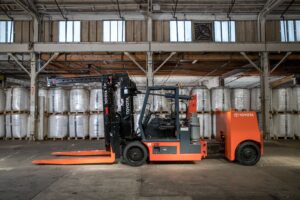

How to Correctly Water Your Forklift Battery
Electricity and water don’t mix until it’s time for forklift battery maintenance. Cool, and refreshing, H2O doesn’t just keep your body running – water is crucial for proper battery function in electric forklifts. With a few basic tips and the right equipment, you can help ensure that you know how to water your forklift battery.
Improper water levels can lower battery life and reduce the cycle time between charges, decreasing your forklift’s effectiveness while increasing energy and maintenance costs.
In modern lead acid batteries that run most electric forklifts, water fills the individual cells to ensure a functional mix of the chemicals and electrolytes that power the equipment. Should water levels dip too low in your forklift battery, it can cause preventable damage to your equipment. Improper water levels can lower battery life and reduce the cycle time between charges, decreasing your forklift’s effectiveness while increasing energy and maintenance costs. To prevent this damage, you should do the following:
- Water the battery after charging. Unless the metal plates of the individual cells are exposed, watering before charging can cause overflows and electrolyte imbalance. If the plates are exposed, top the battery enough to cover them, recharge them, and then complete regular watering after charging.
- Use pure or distilled water. Water that is dirty or filled with particulates can cause electrolyte imbalances and damage the battery. Distilled water isn’t usually needed so long as pure, clean water is used.
- If available, use a single-point watering system. They save you time and make sure water levels are appropriate in all battery cells.
- Avoid lengthy exposure to cold temperatures. If water freezes in your batteries, it can damage them.
New forklift batteries can be expensive. Take care of what you have and you’ll be a hero for your boss and your business.
Share this Post
Other Post



Toyota’s Moving Mast Reach Trucks: A Versatile Warehouse Solution




